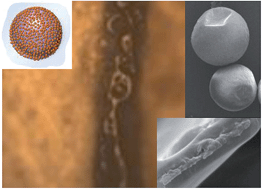Multilayer composite microcapsules synthesized by Pickering emulsion templates and their application in self-healing coating†
Abstract
Multilayer composite microcapsules, richly and efficiently loaded with a healing reagent (isophorone diisocyanate, IPDI), are prepared based on lignin nanoparticle-stabilized oil-in-water (O/W) Pickering emulsion templates. Size control of the microcapsules is conducted by varying the lignin content and the oil–water volume ratios of the Pickering emulsions. Using scanning electron microscopy (SEM) and optical microscopy (OM), the resulting microcapsules were shown to be spherical in shape, with an ideal structure of a rough outer surface and a smooth inner surface, and a shell thickness of 4.5 μm and a mean diameter of 40–117 μm. Fourier transform infrared (FTIR) spectra and thermal gravimetric analysis (TGA) reveal the extraordinary characteristics of the capsules: a core fraction of 81.1 wt%, excellent thermal stability with the initial evaporating temperature of IPDI elevated by 72 °C, and high durability in aqueous solution-submersion and air-exposure tests with a mass loss of about 9.7 wt% after four days submersion or two weeks exposure. Furthermore, the microcapsules are embedded into epoxy coatings to apply this technology to anticorrosive polymer coatings. Investigations by brine-submersion corrosion-accelerating tests demonstrate that the self-healing microcapsules incorporated into the epoxy coatings on steel plates are well dispersed in the coating and have a favourable anticorrosive effect.



 Please wait while we load your content...
Please wait while we load your content...